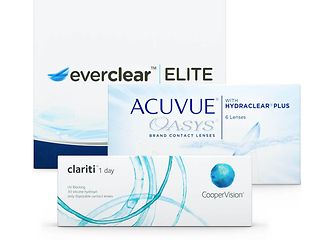Being protected against harmful UV rays is very important, as they carry more risk to your eyes than you might be aware of. We're exposed to both UV-A and UV-B rays all year round and on a daily basis, even cloudy days, and that's where wearing Contact Lenses with UV protection can be hugely beneficial to the health of your eyes.
UV contact lenses: how do they work?

What are UV rays?
UV radiation or UV rays, are the names we give to the Ultraviolet light band of the electromagnetic spectrum. With a wavelength range between 100-400nm, they are invisible to humans but some insects, birds and mammals can see it. UV rays are usually divided into two subgroups: UV-A rays (325-400nm) and UV-B (280-315nm). There are also UV-C rays, but they are completely absorbed by the earth's ozone and atmosphere, so don't affect us.
Dangers of UV radiation: Why use UV contact lenses?
UV rays are very powerful, overexposure to UV light can cause suntan, sunburn or even skin cancer. Of course, they also affect our eyes and they can be very damaging:
- Photokeratitis: Also known as ultraviolet keratitis, photokeratitis happens when the ultraviolet rays burn your cornea and conjunctiva due to insufficient protection. This can cause pain, tears, eyelid twitching and light sensitivity.
- Pterygium: Long exposure to UV rays is considered to be one of the causes (but not the only one) of this abnormal growth of the conjunctive over the white part of your eye. It can generate discomfort, redness and blurred vision. Pterygium is also known as surfer's eye, due to its prevalence among surfers, who spend a considerable amount of time exposed to UV, wind and sand.
- Eye Cancer: Some studies suggest that UV rays may have links with some types of eye cancer, such as eye melanoma.
- Cataracts: Long exposure to UV rays increases the chance of generating cataracts.
- Age-related macular degeneration (AMD): Studies suggest that AMD, when the macula from the retina gets damaged, could be accelerated due to the exposure to UV radiation.
Contact lens UV blocking classifications
Contact lenses can be labelled with different levels of protection depending on the percentage of UV rays they are able to block:
- Class 1 UV blocking: The highest level of protection. Contact lenses that are able to block 90% of UV-A rays and 99% of UV-B rays.
- Class 2 UV blocking: Contact lenses that block 70% of UV-A rays and 95% of UV-B rays

Myths about UV protection for your eyes
- You only need eye UV protection in Summer: False. Solar radiation is always present and that's why we should take it into account on a day to day basis. Our eyes need good UV protection all year round, no matter the season or the weather.
- You don't need eye protection on cloudy days: False. As we have seen, UV rays are invisible to humans and they cannot be identified just by checking whether it's sunny or not. Even on cloudy days your eyes can get damaged, sometimes more than on bright days - we tend to forget to take care!
- You need sun protection for your eyes during outdoor activities: True. A very familiar example is skiing with UV contact lenses, as snow reflects up to 80% of UV rays. But many people tend to forget that eye protection is also needed in many other “less exceptional” occasions. UV rays are reflected by all kinds of surfaces. For example, water can reflect up to 100% of rays and sand up to 25%. This means that no matter where you're exercising, whether it's on the beach, next to a river or in a park, you still need to take care of your vision. Read more about contact lenses for sports.
- Midday sun is the most damaging light for your eyes: False. At midday the sun is at its highest point and that's why we have the feeling it's more intense. But with the sun in that position our eyebrows protect us better against the rays coming down vertically. Sunset and sunrise, when the sun is lower, are actually the most dangerous times for your vision, as the rays travel to your eyes horizontally.
- Sunglasses alone are enough to protect my eyes from UV rays: False. While a pair of good quality sunglasses is essential to fight against UV radiation, some rays may get to your eyes through the gaps, unless they are wrap-around frames. Remember that UV rays move in many different directions. Contact lenses with UV protection cover a bigger area of your eye, that's why they are the best complement to sunglasses. Remember, UV contact lenses are not a substitute for sunglasses, on the contrary, both combined are the best option to help fight UV radiation.
Contact lenses with UV protection
Fortunately, day after day many contact lens manufacturers are including UV filters in their models. No matter what type of lens you use, dailies or monthlies, toric or multifocal, you will find contact lenses to protect you from UV radiation. If you are wondering which contact lenses have UV protection from the ones available on VisionDirect.ie, please find below a list of models and their UV blocking class:
The availability of UV-blocking technology varies between manufacturers and models, so if your contact lenses are sold in Vision Direct but you can't find them in this list, it means that it doesn't include UV protection. If due to your lifestyle you spend much time outdoors or you are simply worried about your eye health, consider wearing contact lenses with UV filters. Please get in touch with your optician to get a recommendation adapted to your needs.

Contact lenses with Class 1 UV blocking
| Model | Type of lens |
|---|---|
| 1 Day Acuvue Trueye | Daily |
| Acuvue Oasys 1 DAY with HydraLuxe | Daily |
| Acuvue Oasys | 2 weekly |
| Acuvue Vita | Monthly |
| Avaira Vitality | Monthly |
| Acuvue Oasys 1 Day for Astigmatism | Daily Toric |
| Acuvue Oasys for Astigmatism | 2 weekly Toric |
| Avaira Vitality Toric | Monthly Toric |
| Acuvue Oasys for Presbyopia | 2 weekly Multifocal |
| Model | Type of lens |
|---|---|
| 1 Day Acuvue Trueye | Daily |
| Acuvue Oasys 1 DAY with HydraLuxe | Daily |
| Acuvue Oasys | 2 weekly |
| Acuvue Vita | Monthly |
| Avaira Vitality | Monthly |
| Acuvue Oasys 1 Day for Astigmatism | Daily Toric |
| Acuvue Oasys for Astigmatism | 2 weekly Toric |
| Avaira Vitality Toric | Monthly Toric |
| Acuvue Oasys for Presbyopia | 2 weekly Multifocal |
Contact lenses with Class 2 UV blocking
| Model | Type of lens |
|---|---|
| 1 Day Acuvue | Daily |
| 1 Day Acuvue Moist | Daily |
| Biotrue One Day | Daily |
| Clariti 1 Day | Daily |
| MyDay | Daily |
| 1 Day Acuvue Define Shimmer | Daily Coloured |
| 1 Day Acuvue Define Sparkle | Daily Coloured |
| Acuvue 2 | 2 weekly |
| Acuvue Advance | 2 weekly |
| everclear ADM | Daily |
| everclear PLUS | 2 weekly |
| Biomedics 55 Evolution | Monthly |
| everclear AIR | Monthly |
| everclear UV | Monthly |
| 1 Day Acuvue for Astigmatism | Daily Toric |
| 1 Day Acuvue Moist for Astigmatism | Daily Toric |
| Clariti 1 Day Toric | Daily Toric |
| MyDay Toric | Daily Toric |
| Biomedics Toric | Monthly Toric |
| 1 Day Acuvue Moist Multifocal | Daily Multifocal |
| Biotrue ONEday for Presbyopia | Daily Multifocal |
| Clariti 1 Day Multifocal | Daily Multifocal |
| Model | Type of lens |
|---|---|
| 1 Day Acuvue | Daily |
| 1 Day Acuvue Moist | Daily |
| Biotrue One Day | Daily |
| Clariti 1 Day | Daily |
| MyDay | Daily |
| 1 Day Acuvue Define Shimmer | Daily Coloured |
| 1 Day Acuvue Define Sparkle | Daily Coloured |
| Acuvue 2 | 2 weekly |
| Acuvue Advance | 2 weekly |
| everclear ADM | Daily |
| everclear PLUS | 2 weekly |
| Biomedics 55 Evolution | Monthly |
| everclear AIR | Monthly |
| everclear UV | Monthly |
| 1 Day Acuvue for Astigmatism | Daily Toric |
| 1 Day Acuvue Moist for Astigmatism | Daily Toric |
| Clariti 1 Day Toric | Daily Toric |
| MyDay Toric | Daily Toric |
| Biomedics Toric | Monthly Toric |
| 1 Day Acuvue Moist Multifocal | Daily Multifocal |
| Biotrue ONEday for Presbyopia | Daily Multifocal |
| Clariti 1 Day Multifocal | Daily Multifocal |
The availability of UV-blocking technology varies between manufacturers and models, so if your contact lenses are sold at VisionDirect.ie but you can't find them in this list, it means that it doesn't include UV protection.
If due to your lifestyle you spend much time outdoors or you are simply worried about your eye health, consider wearing contact lenses with UV filters. Please get in touch with your optician to get a recommendation adapted to your needs.